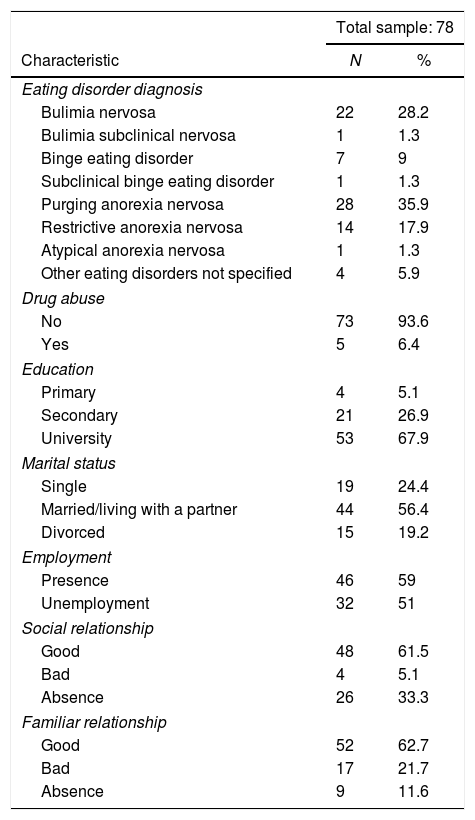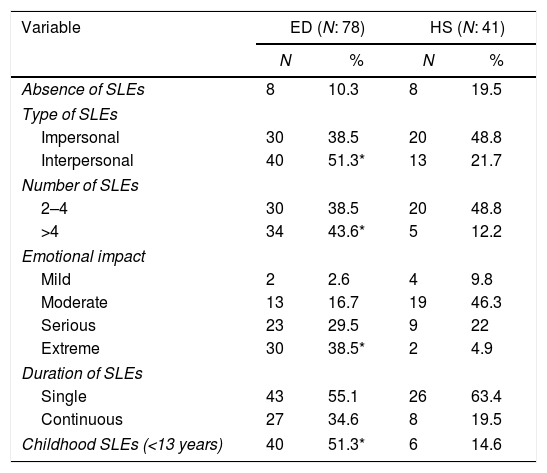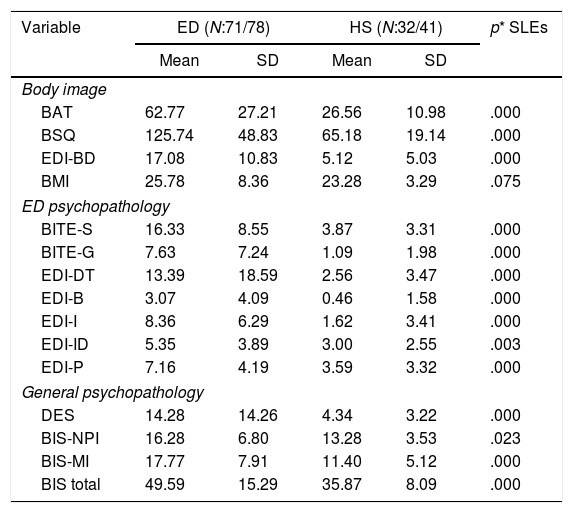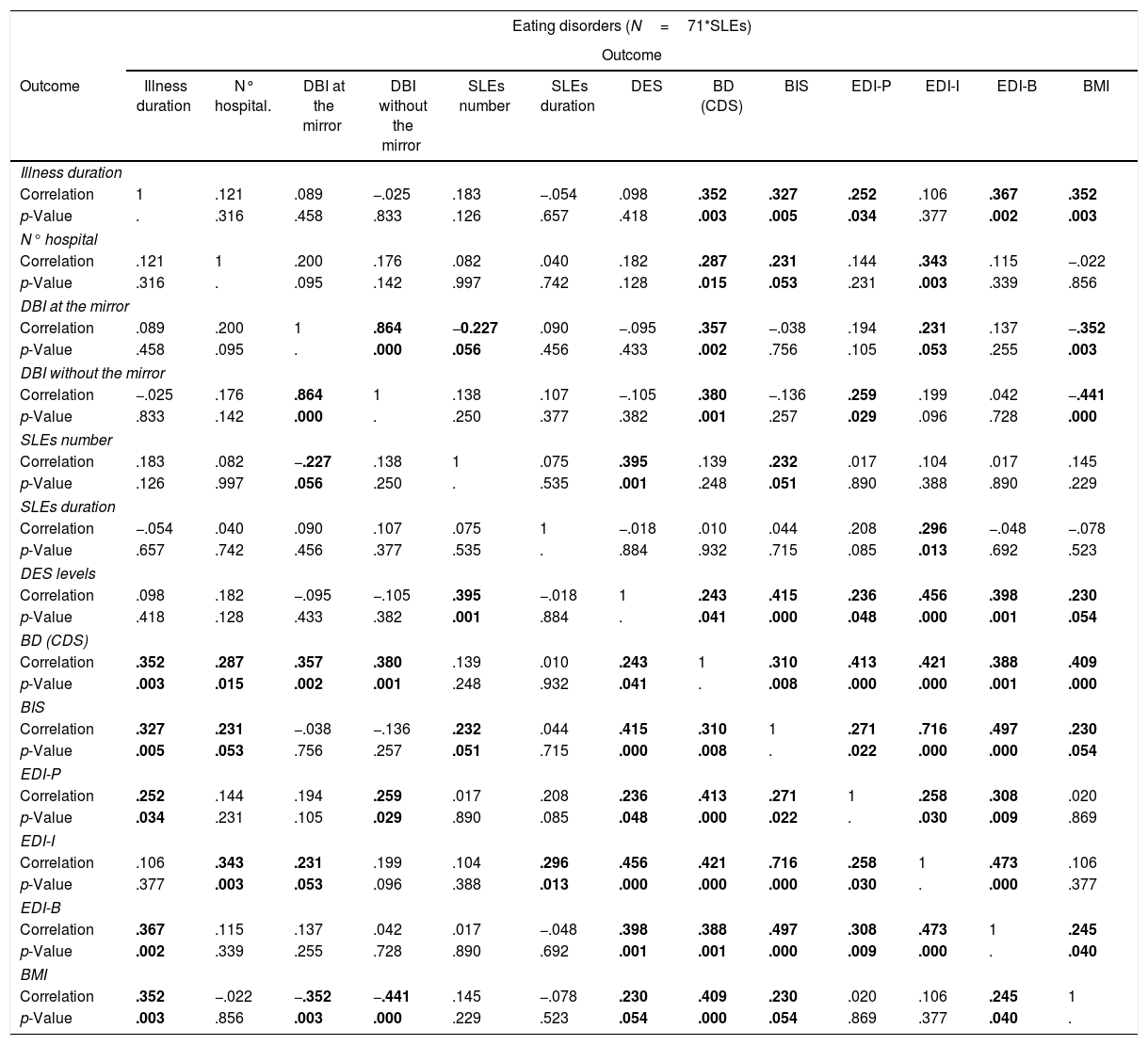A distorted body image and body dissatisfaction (BD) are key features of eating disorders (ED). Stressful life events (SLEs) are involved in the evolution of the illness. The study aims to evaluate the relationship between SLEs and disturbance in body image.
MethodCross-sectional, retrospective study. ED participants were outpatients from the unit care of ED. Healthy subjects (HS) were recruited by general advisements. A final sample of 119 (78 patients and 41 HS) was recruited. The traumatic life event questionnaire, the dissociative experiences scale, the Contour Drawing Rating Scale, and the eating disorder inventory (EDI) were used for assessment.
ResultsNo differences between groups were found in mean age, sex, level of study, or SLEs prevalence. ED patients reported significantly more levels of dissociative experiences, BD, and body misperception. ED patients who reported SLEs presented more levels of dissociation, bulimia, perfectionism, impulsivity, and overestimation of the shape in the mirror. Besides, patients who overestimated their shape seemed to show more impulsivity. BD correlated with social insecurity and binging in the control group. HS with overestimation of their shape presented more punctuation in the EDI subscale of bulimia.
ConclusionsED patients tend to overestimate their bodies more than HS both when they look in the mirror and when they feel their shape. Those with a greater number of SLEs have greater levels of dissociation. The presence of interpersonal SLEs determined more perfectionism, impulsivity, a distorted body image in the mirror, and a drive of thinness only in ED patients, while healthy subjects reported more anxiety, social insecurity, and non-planned impulsivity.
La distorsión y la insatisfacción de la imagen corporal son aspectos clave de los trastornos alimentarios (TA). Los eventos estresantes vitales (EEV) se han involucrado en la evolución de la enfermedad. El objetivo del presente trabajo es estudiar la relación entre los EEV y la distorsión de la imagen corporal.
MétodoSe realizó un estudio retrospectivo caso-control con 78 pacientes en tratamiento ambulatorio que se reclutaron consecutivamente en una unidad de TA, y 41 sujetos sanos. Para la evaluación se utilizaron el cuestionario de eventos traumáticos, la escala de experiencias disociativas, el test de la silueta y el inventario de trastornos alimentarios (EDI).
ResultadosNo hubo diferencia entre grupos para la edad, el sexo, el nivel de estudios o la prevalencia de EEV. Los pacientes con TA refirieron significativamente más experiencias disociativas, más insatisfacción y más distorsión corporal. Los pacientes con TA y EEV tenían más niveles de disociación, bulimia, perfeccionismo, impulsividad y sobreestimación de la silueta al espejo. Los pacientes más impulsivos presentan más distorsión de la imagen corporal. En los controles sanos la insatisfacción corporal se asocia a inseguridad social e impulsividad y, los que sobrestiman su silueta, muestran asociación positiva con la subescala EDI de bulimia.
ConclusionesLos pacientes con TA sobrestiman su figura, sea al espejo o sin él. Los que tienen más EEV presentan más experiencias disociativas. La presencia de EEV interpersonales determina más perfeccionismo, impulsividad, distorsión de la imagen corporal y obsesión para la delgadez solo en los pacientes, mientras que en los controles sanos se asocian a más ansiedad, inseguridad social e impulsividad no planificada.
Artículo
Comprando el artículo el PDF del mismo podrá ser descargado
Precio 19,34 €
Comprar ahora










